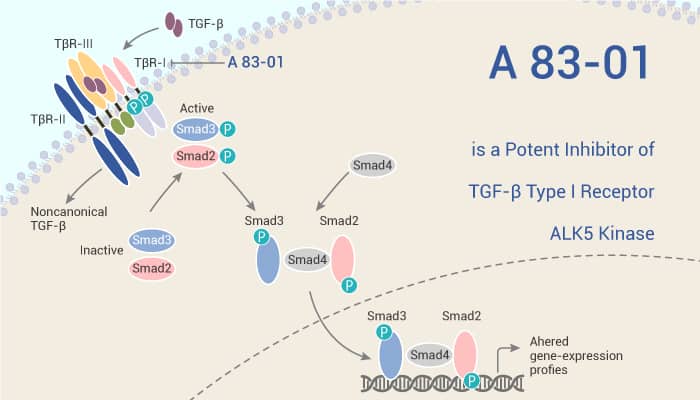TGF-β, activin, nodal, and bone morphogenetic proteins (BMPs) belong to the TGF-β superfamily. It regulates a wide range of cellular responses, including cell proliferation, differentiation, adhesion, migration, and apoptosis.
TGF-β and related proteins transduce signals through two distinct serine/threonine kinase receptors, including type I and type II.
The function of TGF-β in cancer biology is complex. As a result, it can suppress or promote tumor growth depending on the type of cancer.
In this article, we will introduce a potent TGF-β type I receptor inhibitor, A 83-01.

A 83-01 inhibits ALK5 kinase, type I nodal receptor ALK4 and type I nodal receptor ALK7. The IC50 values for ALK5, ALK4, and ALK7 kinases are 12 nM, 45 nM, and 7.5 nM, respectively.
In Mv1Lu cells, A 83-01 reduces the level of ALK-5-induced transcription with an IC50 of 12 nM. It also blocks the ALK4-TD and ALK7-TD induced transcription with IC50s of 45 nM and 7.5 nM in R4-2 cells. Additionally, this compound weakly suppresses that induced by constitutively active ALK-6, ALK-2, ALK-3, and ALK-1.
In Hacat cells, A 83-01 potently prevents the growth-inhibitory effects of TGF-β. Besides, it completely inhibits the effect at 3 µM. Notably, A 83-01 inhibits TGF-β-induced Smad activation in HaCaT cells.
A 83-01 (1 µM) decreases cell motility, adhesion, and invasion by TGF-β1 in HM-1 cells. But it does not change cell proliferation.
Ovarian cancer is the most lethal gynecologic cancer in the western world. There is an urgent need to develop new treatment modalities for ovarian cancer.
In vivo experiments, Peritoneal injection of A-83-01 twice a week for 4 weeks at doses of 50-500 μg does not influence body weight or neurobehavioral appearances. HM-1 cells into B6C3F1 mice lead to ascites accumulation with diffuse disseminated tumors on the peritoneum. A-83-01 significantly improves the survival of the mice. Additionally, it slowers the formation of ascites in mice.
In conclusion, A-83-01 is a potent ALK5/4/7 kinases inhibitor with anti-cancer activities.
[1]. Tojo M, et al. Cancer Sci. 2005 Nov;96(11):791-800.
[2]. Yamamura S, et al. Int J Cancer. 2012 Jan 1;130(1):20-8.